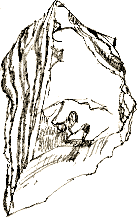
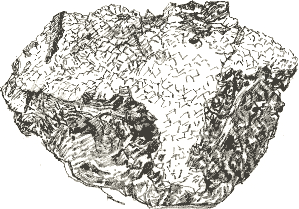 THE LAYERS in Tiger’s Eye (left) have a texture that looks
like the fibres
of asbestos and that’s what the mineral originally consisted of; quartz
has replaced the original asbestos fibres, creating what’s termed a pseudomorph.
The mineral crocidolite also occurs in Tiger’s Eye. Crocidolite
has nothing
to do with crocodiles – the name is derived from the Greek krokis lithos, ‘fibre
stone’. Crocidolite is acid-proof and is used in insulation.
THE LAYERS in Tiger’s Eye (left) have a texture that looks
like the fibres
of asbestos and that’s what the mineral originally consisted of; quartz
has replaced the original asbestos fibres, creating what’s termed a pseudomorph.
The mineral crocidolite also occurs in Tiger’s Eye. Crocidolite
has nothing
to do with crocodiles – the name is derived from the Greek krokis lithos, ‘fibre
stone’. Crocidolite is acid-proof and is used in insulation.
Here’s
a more familiar form of quartz (right); these crystals
formed in a cavity as mineral-rich fluid and gases flowed through the rock.
Quartz has
six-sided crystals and
it is harder than steel.
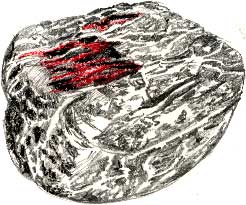
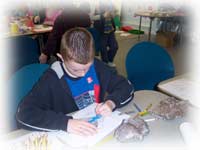 Often
veined and banded, the medium-sized crystals in Serpentine have
the appearance of snake-skin. The Lizard Peninsula in Cornwall gets its name
from this rock. The large red crystal is jasper.
Often
veined and banded, the medium-sized crystals in Serpentine have
the appearance of snake-skin. The Lizard Peninsula in Cornwall gets its name
from this rock. The large red crystal is jasper.
I'm here at Cliffe Castle Museum, Keighley, with members
of the West
Yorkshire Geology Trust for a day of activities centred on the museum's
impressive mineral collection. I'm drawing along with children using pencil
on paper (with a little wax
crayon) which makes a change from my usual pen and ink and watercolour. 'Lead'
pencils are made from graphite set in a clay matrix. Graphite
is a form of carbon with a melting point of 3,500 °C. It
is a thermal and electrical conductor and is used in nuclear reactors.
Molecules, Minerals, Matter
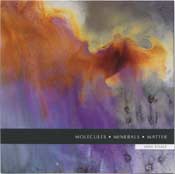 There's
also an opportunity to work in colour with artist in residence Jane
Foale whose
recent swirling colour experiments (left) have been inspired by the
mineral collection. Some of the minerals on display are the source of
colours in the paintbox. In Jane's work they interact in unpredictable
ways, often strikingly like the patterns in minerals, for instance Derbyshire
Blue John. She has exhibited some of her colour work, set in perspex and backlit.
If they
hadn't been labelled I would have guessed that these were wafer thin sections
of minerals. Jane suspects that some of the interaction of the pigments she
has
been using
takes
place
at a molecular level and she plans to take a look at some of the interesting
areas with a microscope.
There's
also an opportunity to work in colour with artist in residence Jane
Foale whose
recent swirling colour experiments (left) have been inspired by the
mineral collection. Some of the minerals on display are the source of
colours in the paintbox. In Jane's work they interact in unpredictable
ways, often strikingly like the patterns in minerals, for instance Derbyshire
Blue John. She has exhibited some of her colour work, set in perspex and backlit.
If they
hadn't been labelled I would have guessed that these were wafer thin sections
of minerals. Jane suspects that some of the interaction of the pigments she
has
been using
takes
place
at a molecular level and she plans to take a look at some of the interesting
areas with a microscope.
Like others, I find the patterns in her work - and in the minerals - resemble
satellite photographs of the surface of planets, or of nebulae. Jane suggests
that this is because similar principles are at work on the micro and macro
scale.
A colour leaflet on her work is available free of charge from the museum.
Links
Cliffe Castle Museum
Jane Foale
West Yorkshire Geology Trust

 THE LAYERS in Tiger’s Eye (left) have a texture that looks
like the fibres
of asbestos and that’s what the mineral originally consisted of; quartz
has replaced the original asbestos fibres, creating what’s termed a pseudomorph.
The mineral crocidolite also occurs in Tiger’s Eye. Crocidolite
has nothing
to do with crocodiles – the name is derived from the Greek krokis lithos, ‘fibre
stone’. Crocidolite is acid-proof and is used in insulation.
THE LAYERS in Tiger’s Eye (left) have a texture that looks
like the fibres
of asbestos and that’s what the mineral originally consisted of; quartz
has replaced the original asbestos fibres, creating what’s termed a pseudomorph.
The mineral crocidolite also occurs in Tiger’s Eye. Crocidolite
has nothing
to do with crocodiles – the name is derived from the Greek krokis lithos, ‘fibre
stone’. Crocidolite is acid-proof and is used in insulation.
 Often
veined and banded, the medium-sized crystals in Serpentine have
the appearance of snake-skin. The Lizard Peninsula in Cornwall gets its name
from this rock. The large red crystal is jasper.
Often
veined and banded, the medium-sized crystals in Serpentine have
the appearance of snake-skin. The Lizard Peninsula in Cornwall gets its name
from this rock. The large red crystal is jasper. There's
also an opportunity to work in colour with artist in residence Jane
Foale whose
recent swirling colour experiments (left) have been inspired by the
mineral collection. Some of the minerals on display are the source of
colours in the paintbox. In Jane's work they interact in unpredictable
ways, often strikingly like the patterns in minerals, for instance Derbyshire
Blue John. She has exhibited some of her colour work, set in perspex and backlit.
If they
hadn't been labelled I would have guessed that these were wafer thin sections
of minerals. Jane suspects that some of the interaction of the pigments she
has
been using
takes
place
at a molecular level and she plans to take a look at some of the interesting
areas with a microscope.
There's
also an opportunity to work in colour with artist in residence Jane
Foale whose
recent swirling colour experiments (left) have been inspired by the
mineral collection. Some of the minerals on display are the source of
colours in the paintbox. In Jane's work they interact in unpredictable
ways, often strikingly like the patterns in minerals, for instance Derbyshire
Blue John. She has exhibited some of her colour work, set in perspex and backlit.
If they
hadn't been labelled I would have guessed that these were wafer thin sections
of minerals. Jane suspects that some of the interaction of the pigments she
has
been using
takes
place
at a molecular level and she plans to take a look at some of the interesting
areas with a microscope.